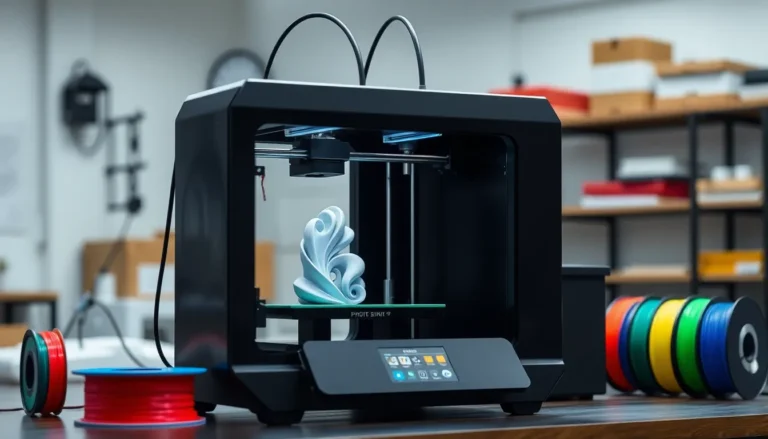Table of Contents
ToggleThe Internet of Things (IoT) is revolutionizing how devices interact and communicate, creating a seamless network that enhances everyday life. As more devices become interconnected, understanding the IoT lifecycle becomes crucial for developers, businesses, and consumers alike. Each phase of this lifecycle—from conception and design to deployment and maintenance—plays a vital role in ensuring the efficiency and effectiveness of IoT solutions.
Navigating the complexities of the IoT lifecycle can seem daunting, but grasping its stages helps in maximizing the potential of connected devices. By exploring each phase, stakeholders can identify opportunities for innovation, streamline processes, and address challenges that arise. As the IoT landscape continues to evolve, a solid grasp of its lifecycle will empower organizations to stay ahead of the curve.
Overview of IoT Lifecycle
The IoT lifecycle encompasses several critical phases. Each phase impacts the overall effectiveness of IoT solutions, shaping how devices connect and communicate.
- Conception
In this phase, stakeholders identify problems and define requirements. They assess market demands to ensure the IoT solution addresses specific needs.
- Design
During design, developers create the architecture of the IoT system. They select appropriate hardware, software, and communication protocols, ensuring scalability and security.
- Development
The development phase involves coding and implementing the design. Teams integrate sensors, applications, and cloud components to facilitate data collection and analysis.
- Deployment
In deployment, the IoT solution transitions from development to operational status. Deployment occurs with the installation of devices in real-world environments, followed by connectivity tests.
- Operation
The operation phase focuses on the live performance of the IoT system. Monitoring tools track device functionality and data flow, ensuring optimal performance.
- Maintenance
Maintenance entails regular updates and troubleshooting. This phase addresses software bugs, hardware failures, and system upgrades to enhance functionality.
- End-of-Life
The end-of-life phase evaluates devices for decommissioning or recycling. Organizations assess the need for replacement or technological upgrades based on system performance.
Understanding these phases enhances the entire IoT ecosystem, enabling stakeholders to maximize the potential of IoT devices and services.
Phases of IoT Lifecycle

The IoT lifecycle consists of distinct phases that contribute to the effectiveness and efficiency of IoT solutions. Each phase plays a crucial role in ensuring successful development, deployment, and operation.
Sensing
Sensing serves as the initial phase where devices gather data from their environment. Sensors detect physical phenomena, such as temperature, humidity, motion, and light, converting them into digital signals. These signals provide valuable information, enabling devices to respond to real-time conditions. Examples of sensors include temperature sensors in smart thermostats and motion sensors in security systems.
Connectivity
Connectivity establishes communication pathways between devices and networks. This phase involves selecting suitable protocols, such as Wi-Fi, Bluetooth, or cellular, to facilitate data transfer. Secure and reliable connections are essential for ensuring real-time data exchange and device interoperability. Examples include home automation systems that connect smart devices through Zigbee and industrial IoT applications utilizing LoRaWAN.
Processing
Processing involves handling the data collected during sensing and connectivity. Edge computing and cloud computing play significant roles in this phase. Edge devices perform preliminary data analysis locally, reducing latency and bandwidth usage. Meanwhile, cloud systems manage larger data sets for more complex analyses. Examples include smart cameras that process video feeds in real time and cloud platforms analyzing aggregated data for insights.
Analytics
Analytics transforms raw data into actionable insights through various techniques like machine learning and data mining. This phase examines patterns, trends, and anomalies, enabling organizations to make informed decisions. Predictive analytics can anticipate future events based on historical data, enhancing operational efficiency. For example, predictive maintenance in manufacturing uses analytics to foresee equipment failures and reduce downtime.
Application
Application represents the final phase, where insights are translated into user-facing solutions. This phase encompasses developing user interfaces, dashboards, and mobile applications tailored to specific user needs. Integration with existing systems ensures seamless functionality. Examples include mobile apps that control smart home devices and enterprise software that manages logistics and inventory through real-time data visualization.
Key Challenges in IoT Lifecycle
The IoT lifecycle presents various challenges that can impact the effectiveness and reliability of IoT solutions. Key challenges include data security, scalability, and device management.
Data Security
Data security remains a top concern in the IoT lifecycle. Devices often collect sensitive information, making them attractive targets for cyberattacks. Implementing strong encryption methods protects data during transmission. Regular security updates guard against vulnerabilities, while comprehensive access controls restrict unauthorized user access. Adhering to security standards, like ISO/IEC 27001, enhances overall system security.
Scalability
Scalability poses significant challenges in the IoT ecosystem. Solutions must accommodate an increasing number of devices without sacrificing performance. Multi-tier architectures allow for seamless integration of additional devices. Cloud solutions provide the flexibility needed to handle fluctuations in data processing and storage demands. Leveraging microservices enables the gradual addition of new functionalities without disrupting existing services.
Device Management
Effective device management is crucial throughout the IoT lifecycle. Managing firmware updates, configurations, and troubleshooting requires efficient processes. Centralized management platforms facilitate monitoring and control of devices across various locations. Automated systems streamline routine tasks and reduce human error. Additionally, establishing clear protocols for device onboarding enhances overall operational efficiency.
Best Practices for Managing IoT Lifecycle
Managing the IoT lifecycle requires adherence to several best practices to ensure efficiency and longevity of IoT systems. These practices encompass strategic planning, implementation, monitoring, and continuous improvement.
Implement Robust Security Measures
Implementing robust security measures throughout the IoT lifecycle proves essential for protecting sensitive data from cyber threats. Employ strong encryption protocols, regularly update security software, and comply with established standards such as ISO/IEC 27001. Establish access controls and perform risk assessments to identify vulnerabilities and mitigate potential breaches.
Utilize Scalable Architectures
Utilizing scalable architectures allows IoT systems to adapt to evolving demands and accommodate a growing number of devices. Opt for multi-tier architectures and cloud-based solutions that facilitate seamless integration and scaling of resources. This approach ensures consistent performance as the network expands, addressing the challenges associated with increased device connectivity.
Emphasize Data Management
Emphasizing data management streamlines the analysis and utilization of collected data. Implement data collection policies, define data retention periods, and ensure compliance with privacy regulations. Prioritize data cleansing procedures to remove redundancies and ensure accurate, actionable insights that enhance decision-making processes within IoT ecosystems.
Monitor Performance Actively
Monitoring performance actively throughout the operational phase ensures optimal functionality of IoT devices. Utilize real-time monitoring tools to track device health, connectivity, and data flow. This proactive approach addresses performance issues promptly and prevents potential failures from escalating.
Foster Collaboration Among Stakeholders
Fostering collaboration among stakeholders—including developers, businesses, and end-users—facilitates better alignment of objectives and enhances innovation. Conduct regular stakeholder meetings to discuss challenges, share insights, and gather feedback. Collaboration aids in refining IoT solutions and adapting to market trends effectively.
Plan for Lifecycle Management
Planning for lifecycle management encompasses anticipating maintenance needs and end-of-life strategies. Integrate regular software updates and conduct hardware assessments to prolong device life. Enact decommissioning plans that include recycling strategies or repurposing outdated devices, promoting sustainability and resource efficiency.
Leverage Automation Tools
Leveraging automation tools can enhance operational efficiency by streamlining processes involved in device management. Automate routine maintenance tasks, updates, and performance monitoring. This approach reduces the workload on IT teams and minimizes the risk of human errors, ensuring consistent device performance.
Implementing these best practices strengthens the management of IoT lifecycles, fostering innovative solutions that adapt to industry demands while optimizing performance and security.
The IoT lifecycle is a critical framework that shapes the development and deployment of connected devices. By understanding each phase—from conception to end-of-life—stakeholders can make informed decisions that enhance the effectiveness of their IoT solutions.
Addressing challenges like data security and scalability is essential for maintaining robust systems. Implementing best practices ensures that organizations can adapt to changing demands while optimizing performance.
Ultimately, a comprehensive grasp of the IoT lifecycle not only drives innovation but also positions businesses to thrive in an increasingly interconnected world. Embracing this knowledge paves the way for successful IoT initiatives that deliver real value.








